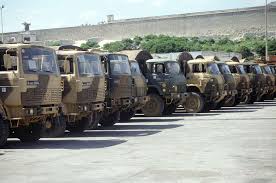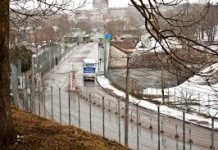
As Russia’s war in Ukraine raises the prospect of a large-scale NATO deployment on its eastern flank, France continues to encounter bureaucratic obstacles that could delay the movement of troops and tanks, according to the French general overseeing military transport coordination.
Brig. Gen. Fabrice Feola, head of France’s Centre for Operations and Transport Support, told reporters Thursday that gaining approval for military convoys to cross neighboring countries currently takes far longer than the European Union’s target of five days—“more like tens of days.”
The EU has pledged to remove the remaining barriers to military mobility through a regulatory proposal this year. A February report from the European Court of Auditors noted that the goal of limiting military border-crossing procedures to five working days by the end of 2023 has faced “progress issues,” with some member states still not meeting the target.
A potential conflict on NATO’s eastern front could require “resource mobilization on a scale not seen in years,” Feola said. He stressed that operational efforts must be streamlined to maintain continuity in troop and equipment projection, particularly as France could serve as a host nation for allied forces arriving on the Atlantic coast.
Feola emphasized that Europe’s overground transport network needs to be thoroughly mapped, recalling Cold War-era capabilities, so there is no uncertainty about the roads and railways’ ability to support heavy military movements.
A major mobilization would also create competition for transport infrastructure, including from the United States, which, in the event of NATO plans, would deploy forces on the Atlantic coast and require passage through France to reach eastern positions. “This notion of competition inevitably leads us to coordinate internationally to make the best use of available resources,” Feola added.
Since Russia’s invasion of Ukraine in 2022, the volume of military equipment transported across Europe has surged, with NATO nations deploying troops eastward, intensifying exercises, and sending billions of euros in aid to Ukraine. Rail has emerged as a cost-effective and rapid method for moving tanks, ammunition, and other heavy equipment over long distances.
In 2024, France organized approximately 150 international military trains, compared with fewer than five annually before the war. These rail movements support a French battalion in Romania and regularly transport equipment to Poland destined for Ukraine.
Feola described the experience of deploying to Romania as “extremely valuable” for the Centre for Operations and Transport Support, providing force projection “on a scale rarely achieved in recent years.” France, along with Germany and the Netherlands, is among the few European nations with a fleet of military rail wagons.
“Railways are an essential mode of transport, particularly as our operational focus has shifted from Africa to Europe, and specifically Eastern Europe,” Feola said.
One major challenge remains verifying route feasibility, such as whether tunnels can accommodate trains carrying military hardware. France is advocating for new EU military mobility rules to designate corridors capable of supporting convoys, with sufficiently strong tunnels, bridges, and roads.
“The current effort involves establishing these corridors and train paths to avoid excessive processing times,” Feola explained. Germany, the Netherlands, and Poland signed a declaration of intent in 2024 to create such a corridor, addressing infrastructure bottlenecks like low bridges and streamlining cross-border transport of ammunition and other hazardous materials.
The EU is exploring ways to simplify procedures across member states. “Reducing the time needed for cross-border authorization, digitizing customs documents—these measures are achievable and increasingly necessary,” Feola said.
While France has standing agreements with neighboring countries for certain standard military convoys, restrictions remain on vehicle numbers and the transport of weapons. French logistics officials are also calling for a centralized authority to coordinate military mobility across Europe, ensuring continuity between countries, corridors, and routes, Feola added.




